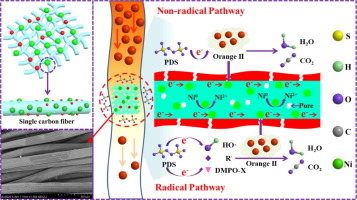Journal of Colloid and Interface Science ( IF 9.9 ) Pub Date : 2018-05-24 , DOI: 10.1016/j.jcis.2018.05.077 Yunjin Yao , Jie Zhang , Mengxue Gao , Maojing Yu , Yi Hu , Zhuoran Cheng , Shaobin Wang

|
An N-doped carbon nanofiber cloth (CC) with anchored nickel nanoparticles ([email protected]) was synthesized from a facile pyrolysis process and employed as a catalyst to oxidize target contaminants using peroxydisulfate (PDS) as both radical precursors and electron acceptors. An effective strategy was developed to control the porous structures and catalytic performances by optimizing the precursor weights and pyrolysis temperatures for [email protected] preparation. The optimal temperature was 700 °C, and the best dicyanodiamine mass was 1.0 g. [email protected] was found to be superior for PDS activation to CC and nickel nanoparticles (NPs), ascribing to highly active sites, intimate connection between the nickel NPs and highly conductive N-doped CC, as well as the formed three-dimensional architecture. The oxidation rates were influenced by the oxidant loading (0.185–1.11 mM), initial organics concentration (10–50 mg/L), temperature (5–45 °C), pH (2.65–10.47), and inorganic anions. Furthermore, mechanistic investigations using various probe reagents and spin trapping technique identified the generation of several active species for oxidation. The reaction was found to proceed via the electron transfer mediation from organics to PDS on N-doped CC and one electron reduction of PDS on Ni0 NPs. This study highlights the design of highly active and reusable heterogeneous carbon/metal hybrids for more efficient PDS activation in environmental remediation.
中文翻译:

负载在氮掺杂碳纳米纤维上的催化镍纳米粒子活化过硫酸盐以降解水中的有机污染物
通过简便的热解工艺合成了具有锚固的镍纳米颗粒([电子邮件保护])的N掺杂碳纳米纤维布(CC),并使用过氧二硫酸盐(PDS)作为自由基前体和电子受体,将其用作氧化目标污染物的催化剂。通过优化用于[电子邮件保护的]制备的前体重量和热解温度,开发了一种有效的策略来控制多孔结构和催化性能。最佳温度为700°C,最佳二氰基二胺质量为1.0 g。[受电子邮件保护]被发现对PDS的活化优于CC和镍纳米颗粒(NP),这归因于高活性位点,镍NP与高导电N掺杂CC之间的紧密连接以及形成的三维结构。氧化速率受氧化剂负载量(0.185–1.11 mM),初始有机物浓度(10–50 mg / L),温度(5–45°C),pH(2.65–10.47)和无机阴离子的影响。此外,使用各种探针试剂和自旋捕集技术进行的机械研究确定了几种用于氧化的活性物质的生成。发现该反应是通过在N掺杂CC上从有机物到PDS的电子转移介导和在Ni上PDS的一次电子还原而进行的0个NP。这项研究突出了高活性和可重复使用的异质碳/金属杂化体的设计,以在环境修复中更有效地激活PDS。


























 京公网安备 11010802027423号
京公网安备 11010802027423号